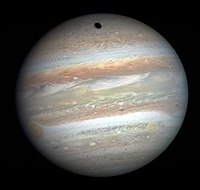
Photo from wikipedia
Throughout the first orbit of the NASA Juno mission around Jupiter, the Jupiter InfraRed Auroral Mapper (JIRAM) targeted the northern and southern polar regions several times. The analyses of the… Click to show full abstract
Throughout the first orbit of the NASA Juno mission around Jupiter, the Jupiter InfraRed Auroral Mapper (JIRAM) targeted the northern and southern polar regions several times. The analyses of the acquired images and spectra confirmed a significant presence of methane (CH4) near both poles through its 3.3 μm emission overlapping the H3+ auroral feature at 3.31 μm. Neither acetylene (C2H2) nor ethane (C2H6) have been observed so far. The analysis method, developed for the retrieval of H3+ temperature and abundances and applied to the JIRAM-measured spectra, has enabled an estimate of the effective temperature for methane peak emission and the distribution of its spectral contribution in the polar regions. The enhanced methane inside the auroral oval regions in the two hemispheres at different longitude suggests an excitation mechanism driven by energized particle precipitation from the magnetosphere.
Journal Title: Geophysical Research Letters
Year Published: 2017
Link to full text (if available)
Share on Social Media: Sign Up to like & get
recommendations!